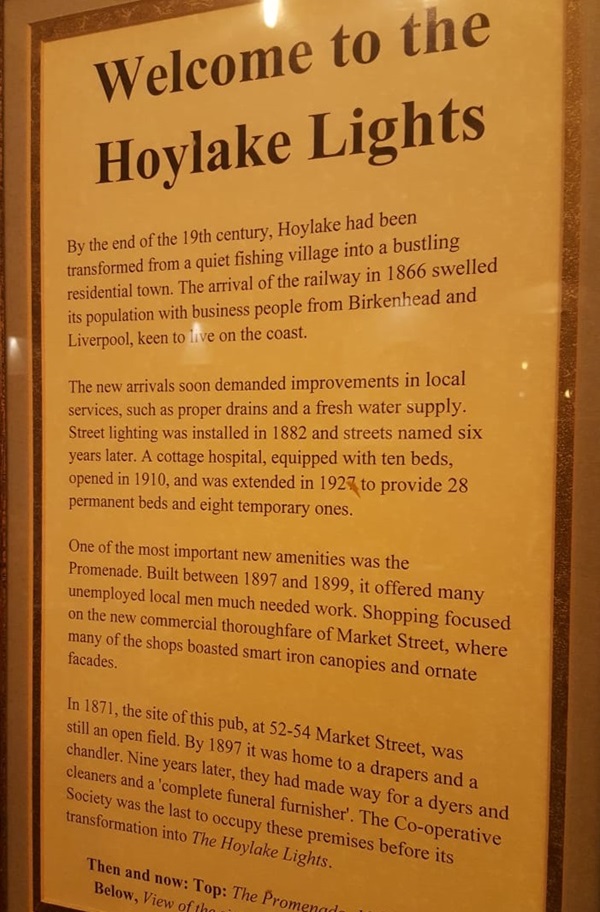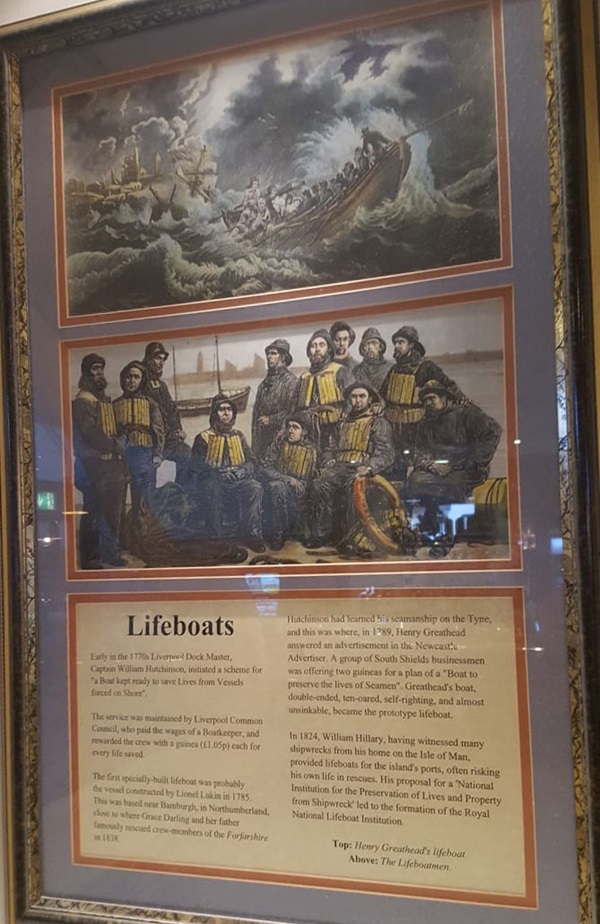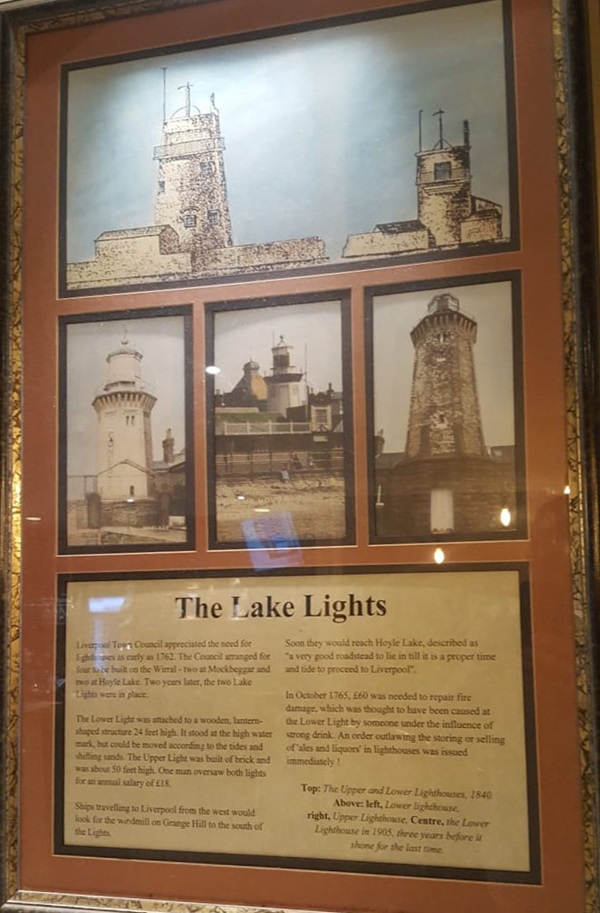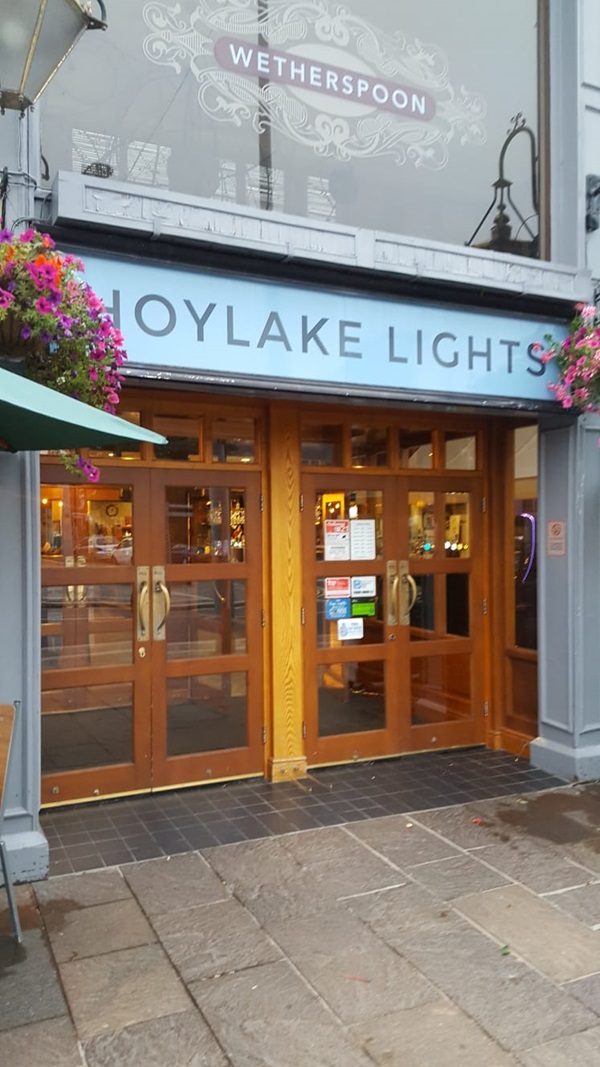This is named after the upper and lower lighthouses, known as the Hoylake Lights, built in the 1760s. Only one of the two lights still stands. In 1871, the site of this pub was still an open field. By 1897, it was home to a draper’s and a chandlery. Nine years later, they had made way for a dyer’s, a cleaner’s and a ‘complete funeral furnisher’. The Co-operative Society was the last to occupy these premises, before transformation into Hoylake Lights.
Text about The Hoylake Lights.

The text reads: By the end of the 19th century, Hoylake had been transformed from a quiet fishing village into a bustling residential town. The arrival of the railway in 1866 swelled its population with business people from Birkenhead and Liverpool, keen to live on the coast.
The new arrivals soon demanded improvements in local services, such as proper drains and a fresh water supply. Street lighting was installed in 1882 and streets named six years later. A cottage hospital, equipped with ten beds, opened in 1910, and was extended in 1927 to provide 28 permanent beds and eight temporary ones.
One of the most important new amenities was the Promenade. Built between 1897 and 1899, it offered many unemployed local men much needed work. Shopping focused on the new commercial thoroughfare of Market Street, where many of the shops boasted smart iron canopies and ornate facades.
In 1871, the site of this pub, at 52-54 Market Street, was still an open field. By 1897 it was home to a drapers and a chandler. Nine years later, they had made way for dyers and cleaners and a ‘complete funeral furnisher’. The Co-operative Society was the last to occupy these premises before its transformation into The Hoylake Lights.
Prints and text about lifeboats.

The text reads: Early in the 1770s Liverpool dock master, Captain William Hutchinson, initiated a scheme for “a boat kept ready to save lives from vessels forced on shore”.
The service was maintained by Liverpool Common Council, who paid the wages of a boatkeeper, and rewarded the crew with a guinea (£1.05) each for every life saved.
The first specifically built lifeboat was probably the vessel constructed by Lionel Lukin in 1785. This was based near Barnburgh, in Northumberland, close to where Grace Darling and her father famously rescued crew members of the Forfarshire in 1838.
Hutchinson had learned his seamanship on the Tyne, and this is where, in 1789, Henry Greathead answered an advertisement in the Newcastle Advertiser. A group of Southshield businessmen was offering two guineas for a plan of a “boat to preserve the lives of seamen”. Greathead’s boat, double ended, ten oared, self-righting, and alomt unsinkable, became the prototype lifeboat.
Top: Henry Greathead’s lifeboat
Above: The lifeboatmen.
Prints and text about the Lake Lights.

The text reads: Liverpool Town Council appreciated the need for lighthouses as early as 1762. The council arranged for four to be built on the Wirral – two at Mockbeggar and two at Hoyle Lake. Two years later, the two Lake Lights were in place.
The Lower Lights was attached to a wooden lantern-shaped structure 24 feet high. It stood at the high water mark but could be moved according to the tides and shifting sands. The Upper Light was built of brick and was about 50 feet high. One man oversaw both lights for an annual salary of £18.
Ships travelling to Liverpool from the west would look for the windmill on Grange Hill to the south of the lights.
Soon they would reach Hoyle Lake, described as “a very good roadstead to lie in till it is a proper time and tide to proceed to Liverpool”.
In October 1765, £60 was needed to repair fire damage, which was thought to have been caused at the Lower Light by someone under the influence of strong drink. An order outlawing the storing or selling of ales and liquors in lighthouses was issued immediately.
Top: The Upper and Lower Lighthouses, 1840
Above: left, Lower Lighthouse, right, Upper Lighthouse, centre, the Lower Lighthouse in 1905, three years before it shone for the last time.
External photograph of the building – main entrance.

If you have information on the history of this pub, then we’d like you to share it with us. Please e-mail all information to: pubhistories@jdwetherspoon.co.uk